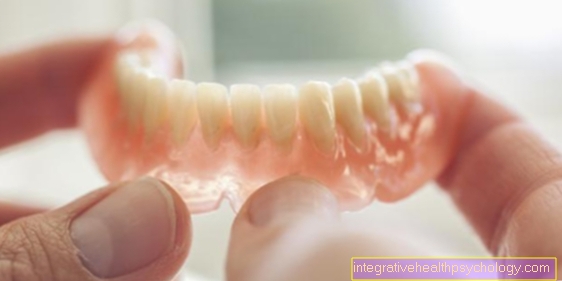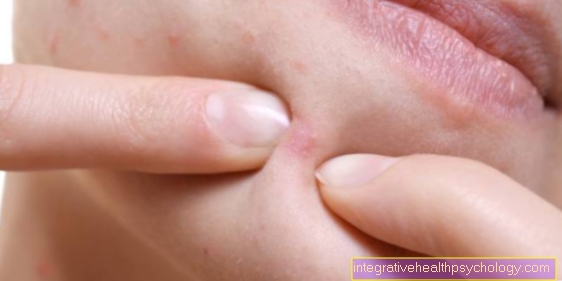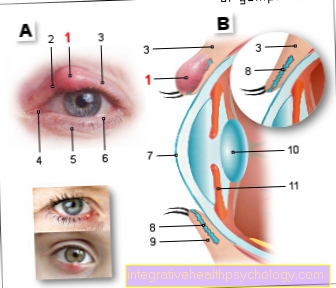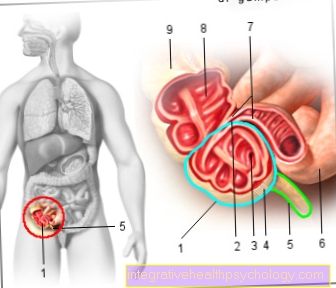Causes of Periodontal Disease
Information in advance
The term periodontal disease is not quite correct here and is rather a collective term for all inflammatory and non-inflammatory diseases of the periodontium.
The disease that most people know as periodontal disease is rather periodontitis, i.e. a disease of the periodontium caused by inflammatory processes. However, because this term is more common, we continue to speak of periodontal disease.
Read more on the topic: Periodontal disease

causes
The causes of periodontal disease can be varied, but most of the time it is similar to caries or gum disease (Gingivitis) caused by bacterial plaque and thus by poor oral hygiene. Plaque is a tough bio-film that consists of both waste products from bacterial metabolism and food residues.
Dental plaque sticks to the tooth surface and even penetrates under the gumline.
There it attaches itself to and around the tooth root and creates deep gum pockets.
In most cases it is pure gingivitis (Gingivitis) cannot be completely separated from the disease of the tooth supporting structure known as periodontal disease.
This is because gingivitis often precedes periodontal disease. The dental plaque (Plaque) leads to inflammation within the gingival pockets, which leads to the characteristic bleeding of the gums.
Inflammation in the area of the gums can also be recognized quickly by laypeople, because the gums lose their rosy, light color in the affected areas and become dark.
A long-lasting, untreated inflammation of the gums (Gingivitis) will in most cases pass to the jawbone and the periodontal membrane of the teeth, in the worst case the bone will recede (Bone loss) and the loss of teeth that lose their anchorage in the jawbone.
Exactly the reasons for these inflammation-related degradation processes have not yet been clarified in detail.
What is certain, however, is that your own immune system and the body's normal defense processes play a decisive role. Although about one in two people has at least one inflammation of the gums (Gingivitis), if not even a real periodontal disease, there are factors that favor a possible disease and thus promote the causes of periodontal disease.
These risk factors include:
- poor oral hygiene
- Tobacco use
- Mouth breathing
- untreated carious teeth
- Life partner with existing periodontal disease (actually periodontal disease),
- Pregnancy and
- a general immune deficiency.
Experts also speak of a genetic predisposition, diseases of the tooth support system (Periodontal disease) to develop.
Inflammation of the gums
Inflammation of the gums, also called "gingivitis", is simply an inflammation of the gums and the gum line. This is caused by pathogenic (harmful) germs and takes place in different stages. At the beginning, a slight inflammation can be combated with very good oral hygiene and various rinsing solutions. However, if the bacteria multiply too much and can even penetrate to the root of the tooth, first a moderate and later a pronounced inflammation of the gums develops.
Spontaneous bleeding and gum pockets are the result. It is then no longer possible to remove the deposits with a toothbrush, which means that the inflammation spreads unrestrictedly. At this stage, however, the inflammation can still be reversed with proper treatment. An improvement in oral hygiene and a reduction in deposits through professional teeth cleaning allow the gingivitis to heal within a short time. However, these measures must also be carried out in the long term in order to prevent the disease and prevent the onset of periodontal disease. This occurs with the transition of gingivitis to the tooth bed and the surrounding bone.
Read more on the topic: Inflammation of the gums
Tartar
Tartar is calcified plaque that adheres to the tooth surface. At home, these calcifications cannot be removed by yourself. Due to their roughness, however, they form a perfect breeding ground for the accumulation of harmful germs and bacteria. The number of germs causing periodontal disease increases and increases the risk of developing it. The tartar ("concrements") located under the gums is particularly dangerous.
It prevents the gums from accumulating on the surface of the tooth root, which is essential for fixed teeth. Furthermore, an increase in tartar even triggers bone loss around the tooth. This leads to a loss of the tooth retaining tissue and the teeth begin to loosen. The body's own fight against bacteria continues to produce metabolic products that attack the healthy own tissue.
Bleeding gums and an increase in the gum pockets are the result. It is therefore all the more important to have the tartar and the calculus removed in the dental practice. Because: fewer harmful germs attach themselves to a smooth tooth surface.
Read more on the topic: Tartar
Smoke
It has been proven that smoking increases the risk of periodontal disease. Depending on the number of cigarettes smoked per day, the risk can increase by up to 15 times and the course of the disease can be accelerated. The smoke that spreads in the mouth changes the environmental conditions for the bacteria in the mouth. The tissues become coarser from the constant irritation, the mouth becomes drier and bacteria that are normally washed away can become lodged.
Harmful germs in particular can grow faster and advance tooth pockets or trigger painful gum inflammation. In addition, the blood flow rate in the tissues in the mouth decreases in smokers, which means that cell renewal takes place more slowly and the rate of self-healing is lower.
As a result, the body is much less able to defend itself against the harmful bacteria and periodontal therapy is not as successful as it is with non-smokers. While the success rate is high here and the pockets decrease by up to 2.5mm on average, this value is only around 1.75mm for smokers. However, by continuously giving up tobacco, the self-healing rate can be improved again and a decrease in the disease can be observed.
diabetes
Even if many are not aware of this, patients with diabetes represent a risk group for the disease of periodontal disease. The risk here is three times higher. The cause is a mutual interplay of both diseases. In the case of diabetes, wound healing in the entire body is disturbed as the smallest vessels clog and the blood flow rate is reduced.
The vessels in the teeth holding apparatus in particular become clogged very quickly, which means that a sufficient supply of blood is not guaranteed and the resistance of the tissue is reduced. However, since harmful bacteria occur in abundance on the gums, they have an easy job and cause the disease to break out quickly.
Mental / psychological causes
Mental and psychological causes can be responsible for the onset of periodontal disease. However, they are not a direct trigger, but cause an incorrect load on the teeth and the tooth support system through grinding or clenching of the teeth at night. Usually a few teeth with a lot of contact are particularly badly affected and can be loosened additionally by the presence of harmful, pathogenic (disease-causing) germs.
The incorrect load is relieved by making a night crunch splint and the progression of the disease is prevented. This treatment can then strengthen the teeth again and slow the course of the disease.
Read more on the topic: Upright rail
stress
The risk of stress in periodontal disease should by no means be underestimated. Both private and professional stress weaken the immune system of the person affected and can thus worsen the prognosis for the disease. A premature onset and rapid course of this disease are possible.
Especially in connection with other risk factors (such as smoking or diabetes) there is a mutual amplification of the disease. However, since stress is not a physical disease and is one of the changeable factors, a rapid reduction in risk can often be brought about here.
























.jpg)



